| The Very Highest Quality Information... |
| Diamond Ring Collets & Setting Styles |
Collets & Settings
First we need to give a few definitions. A collet is the part of a ring which holds the stone. It could also be called a setting. The shank is the part of a ring which goes around the finger, and the shoulder is the transitional part between the shank and the collet or setting. A mount, mounting or ringmount is the empty ring before the diamond is set into it.
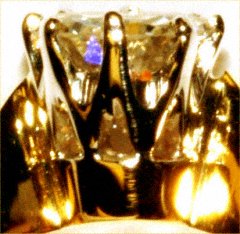 Eight Claw Rex Collet |
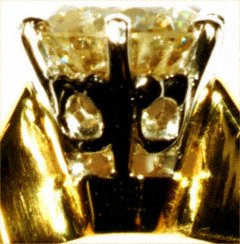 Series 6 Stamped Collet |
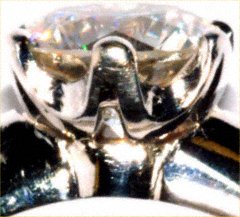 Hand Made 6 Claw Collet |
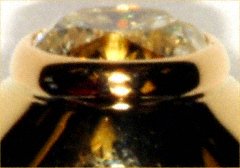 Rim or Rubover Collet In a Domed Gent's Style Ring |
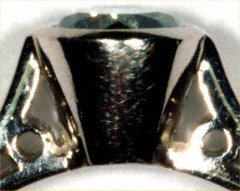 Tapered Solid Rim or Rubover Collet |
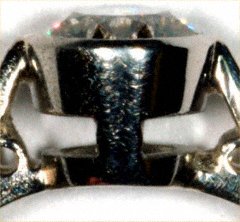 Tapered Rim or Rubover Collet with Cutout Sides |
Stamped Collets Versus Cast Collets
You may notice that some of our collets are described as "stamped", as opposed to cast. Stamping the collet from a single sheet of gold or platinum produces a stronger more durable component, with a smoother cleaner surface. Castings are never quite as strong or reliable, and usually have to be made very slightly thicker to compensate, making them chunkier and less elegant. Castings are also cheaper, which is why most manufacturers now use them. Stampings are better, which is why we use them wherever possible, particularly in crucial areas such as claw set collets, where there are only small amounts of metal holding high value precious gems.
Cast collets are usually cast complete with their underbezels, in which case both will be the same colour. When we make a ring with a yellow gold shank, we often use a yellow underbezel to highlight for the cognoscenti that the collet and underbezel are two separate components, and showing that they are not a single casting*.
With rim set collets, where there is more metal holding the stone, a casting is perfectly adequate because the component can be heavier and more substantial.
* Gold & Rhodium Plating
Some manufacturers make cheap rings by casting the whole ring, or the collet/underbezel combined in one piece, but then either selectively rhodium plating to make the collet appear to be white gold or platinum, or by yellow gold plating the underbezel to create the illusion of a better and more expensive stamping. This plating eventually wears off to leave the ring looking just what it is, a cheap shabby imitation of the real thing.
We usually rhodium plate white gold components such as collets, but never rhodium plate over yellow gold for the reason above, or platinum because it does not need it.
Rex Collets
The rex collet is sometimes called an organ pipe collet, because that's what it looks like to some people. We believe it's name comes from the Latin for king, because it looks rather like a crown. The reason it is so universally popular is that it is difficult to design a better collet. It combines strength with simple elegance. The rex collet sits on a separate underbezel, but when joined by soldering or brazing these often appear to be one single component. When we make a ring with a yellow gold shank, we often use a yellow underbezel to highlight for the cognoscenti that the collet and underbezel are two separate components.
The rex collets we use in our solitaire diamond rings are almost always stamped rather than cast.
Series Six Collets
We still call this a series 6 because that's what Johnson Matthey used to call it, and also their Starlink subsidiary. It probably has other names. It is related to the rex, in that it is stamped out of a single piece of metal, but the open piercing work on the sides is in a different scroll sort of pattern. We prefer it over the rex because it is slightly more substantial, and also looks more elegant, particularly for larger stones.
How Many Claws?
How many claws should the ideal collet have. Some people want the fewest number of claws, so that they can see more of the diamond but more claws usually mean greater security. A low claw count keeps the design clean and uncluttered, but sometimes they need to be thicker to provide strength and security. A higher claw count means each individual claw can be slightly finer and less obtrusive. The size and cost of the diamond is also an important factor. As could be expected, for most diamonds there is a claw count which will provide the best overall compromise. Let's go through some claw counts starting at the lowest:
Two claws might be possible, but would be very unstable and insecure even if the claws were thick and chunky,
Three claws is about the lowest practical count, but does not usually look right because it is assymetrical.
Four claws can look stunning, but the claws usually have to be more substantial than for 6 or 8 claw settings. We sometimes used a stamped four claw collet. If one claw were to break, then there is not much to hold the diamond in place.
Five claws share the same objection as three claws, that of being assymetrical, as do all other odd numbers.
Six claws are a great compromise for most diamonds, we like the series six collet with six claws.
Eight claws add more security for bigger diamonds, but look too fussy and cluttered for smaller stones.
Ten and twelve claws provide increased security as stones get bigger. If they are stamped or hand made, each can be more delicate, adding to the aesthetic qualities of the ring, whereas a lower claw count may look wrong if too fine, or too clunky if made to scale.
We have assumed throughout that we were discussing collets for round stones, fancy shapes dictate a different approach, although some of the same principles apply.
Rim Settings
Rim setting could mathematically be considered to have just one claw, going all the way round the stone, or else an infinite number of claws, which join up into one. It is also mathematically correct to state that they have no claws. In some respects, they give the advantages of both ends of the claw count scale. On the one hand, they are clean and simple, and there are no claws to catch, snag or break. At the other end of the scale, and infinite number of claws suggests an infinitely strong and secure setting. While no setting can be infinitely secure, rim settings do actually offer the benefits of both ends of the scale. They are clean simple and unfussy, while also strong and secure. Because there is metal holding the stone all around, the amount of metal involved can be quite small, leaving plenty of the stone visible to sparkle.
Some people think rim setting hides too much of the stone, but this is not true unless the setting is done very heavy-handedly. Other people consider rim settings to be too heavy looking, but most rim setting will be tapered so their sides remain unobtrusive, and are often pierced to make them appear more delicate.
Hand Made Collets
In Victorian times, a large proportion of jewellery was hand made, and there can be advantages, but not always. The greatest disadvantage is usually cost. It could take a highly skilled craftsman up to a week to make a completely hand made collet, and hand finish and polish every part of it, and a single slip of the hand could ruin the whole job. The labour cost could be over £1,000 and few people would want to pay this sort of money, and it would not necessarily be great value. Consider that a top of the range production Mercedes probably outperforms hand built cars costing twice as much.
We make hand made collets only when we have to, usually because we or our customer wants something individual.
More Collet Styles to Follow
We will be adding more collet styles to this page, and more description.
We also intend to give each ring style its own page, with links to and from this page, to help you decide on which style you would prefer, or which style would be most suitable for you.
To achieve this, we are having to re-photograph a number of our rings, and this takes time. You may wish to bookmark this page so that you can check for updates.
Ring Finger Size Advice - General
Ring Finger Sizes - International Conversion Chart
| ...at the Lowest Possible Price |
| 32 - 36 Harrowside, Blackpool, Lancashire, FY4 1RJ, England. Telephone (44) - (0) 1253 - 343081 ; Fax 408058; E-mail: info@chards.co.uk The URL for our main page is:https://24carat.co.uk | Web Design by Snoop |